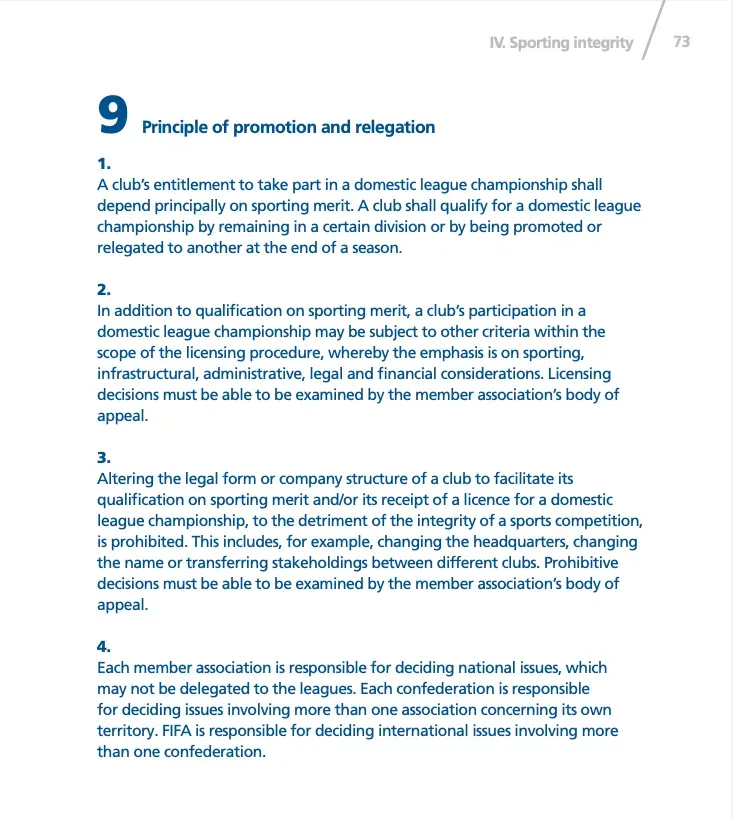Promotion and relegation is simply the way soccer works, and always has, in most nations. But when it comes to pro/rel in the United States, it’s largely a non-starter.
The US league structure that emerged in the early 1900s was one of fractured, competing league entities. This was party due to a large geographic area, but also due to a somewhat “hands-off” approach to overseeing the pro game from our national federation.
But as leagues came and went over the twentieth century, several opportunities for a clean slate presented themselves. But neither the NASL in the 1970s, nor its successor MLS in the 90s, embraced what is the standard throughout much of the world. Even FIFA’s involvement (insistence) on the creation of a first division as a stipulation for the awarding of the 1994 World Cup did not lead to a true American pyramid.
Generally, promotion and relegation is very popular. Fans enjoy it as it creates intrigue at both ends of the table towards the end of a season. It gives, theoretically, any club in any community the opportunity to compete at the highest levels. The principle of meritocracy and inclusiveness is a part of the very fabric of the sport. It’s so ingrained that proposals that might threaten this principle meet heavy criticism, and to date, usually fail.
Analysts, players, and coaches, even those working within the American system, would welcome the concept.
So the question is, when it comes to the USA, who is really against adopting promotion and relegation? But first, a quick refresher on what promotion and relegation actually is may be in order.
The letter of the law
Article 9 of the FIFA Statutes lays out how pro/rel works, and why:

Article 9.1 is the most important, stipulating that participation in a certain league must be based on sporting merit. Currently, neither MLS, USL nor NISA use sporting merit in any way as a qualification for entrance into their league(s).
Article 9.2 notes that other criteria may be used, such as club finances, infrastructure etc., in addition to sporting merit.
Article 9.3 prohibits altering the legal form of a company/club to “…facilitate receipt of a license for a domestic league championship.” It would appear that eight, arguably nine, MLS clubs have violated this statute: Seattle, Portland, Vancouver, Montréal, Orlando, Minnesota, Cincinnati, Nashville, and St. Louis (partial ownership shared with folded USL club it replaced). All were existing USL or NASL teams, which were shuttered and replaced with new legal entities before joining MLS. All without having won on the field to earn a place.
Article 9.4 states that member associations (i.e. USSF) are responsible for deciding these issues, not the leagues (MLS/USL/NISA).
So who are the nay-sayers?
Those sympathetic to adopting pro/rel are often met with vocal detractors. Especially online on social media, comments stubbornly denouncing pro/rel will undoubtedly tag on to anything promoting the idea. Often anonymous users will happily lob criticisms of the system, which can pretty much be boiled down into four categories:
- “No owner will accept going down to a lower league after paying [insert large expansion fee]”
- “It will be a disaster for the league if [insert large city] got sent down”
- “Nobody will watch [insert small city]”
- “Teams will fail if they got relegated”
Even fans and journalists who would happily embrace it will cite the above as reasons why pro/rel won’t happen. That kind of defeatism, to an extent, holds back public enthusiasm and a real movement that goes beyond the tinfoil hat crowd.
Indeed, there is some truth to it… at least the first one. It all comes down to money. No owner would voluntarily put their investment at risk. But the key word is voluntarily. It’s not up to the club owners. As noted above, it’s up to the USSF and FIFA.
Of course, there is the fact that pro/rel does not stop the continuous inflow of investment into clubs all around the world. Even American owners, who would supposedly never go for it, purchase teams in European pro/rel leagues all the time. Even MLS and USMNT co-commentator Stu Holden is part owner of a team in LaLiga. If promotion and relegation didn’t exist, it’s unlikely that Holden would have invested in what was then a second division Spanish team.
A TV ratings fiasco is largely overblown as well. It’s not like national TV games in the past have drawn great numbers anyway. The difference in eyeballs between RBNY vs LAFC and Indianapolis vs Madison airing on FS1 is not large enough to be a real factor here. Besides – with the majority of American men’s and women’s pro soccer games now available exclusively via streaming, hardcore fans of each team are the key demographic.
Billionaires versus almost everybody else
Outside of pro league boardrooms – and those with close business ties to them – you’d be hard-pressed to find many fans, journalists, or others around the game who genuinely would not like to see the US adopt the concept.
Is there really anyone out there with the opinion of “American soccer should only ever have the same 30-ish teams at the top, to cover an entire continent, unless an owner decides to rip one of them out of their community for some reason”?
As someone who grew up a mainstream American sports fan, and who discovered the beauty of soccer (and pro/rel) later in life, personally I would welcome it in all of our sports. And I say that as a fan of three teams (Dolphins, Panthers, Marlins) who, except for a few brief bright spots, would have been relegation risks for much of my lifetime. I’d much prefer to follow a competitive lower division team with something to play for. Too many fans here are presented with a basement-dwelling major league team whose owner(s) get rich off revenue sharing and public tax dollar schemes.
Of course, there’s also the fact that the lack of promotion and relegation in the US, in part, resulted in the famous co-owner of my favorite soccer club Fort Lauderdale Strikers (now, sadly, gone) taking his money to Spain instead.
It would be great… but
Yes, some multi-billionaires could potentially take a hit to their wallets. That’s a risk I’d be willing to live with. Anyone not flying in a private jet to the owners box to take in a game ought to be able to live with it, too.
Nobody wants to see their favorite club in a lower league. But it’s better than the American alternative. Ask fans of perennial losers, relocated teams, or those that have ceased to exist entirely.
We like to think the sport in the US has made incredible progress over the past quarter-century or so. And it has, to an extent. Our disjointed soccer pyramid has managed to deliver its share of bright spots. But it could be a much more vibrant, interesting, and inclusive landscape.
Leagues and clubs (and owners) could still make money. And the vast majority of clubs that get relegated would survive – certainly at a rate no worse than American professional soccer clubs have survived at within our closed system over the past 150+ years.














